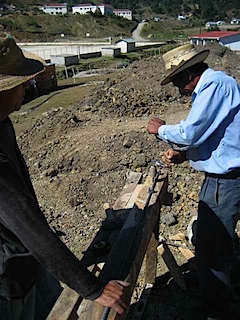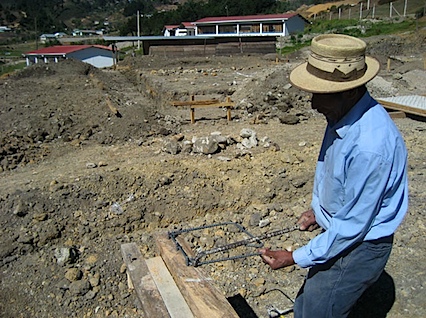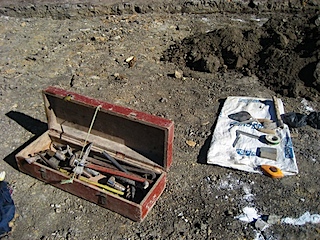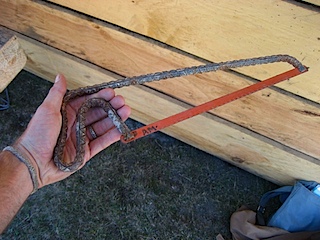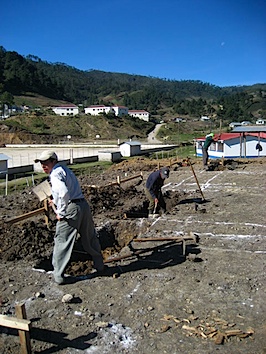 Construction continues on the teachers’ school. Now that the masons have layed out the building, it’s time to start digging the trenches for the footings. Many of the laborers are parents from the PTA (try THAT one in the US, Belkar!). Check out their clothing: they’re showing up in public and working to represent the school, so it’s all done in their Sunday best. Maybe they’re not worried about getting them dirty because it’s their wives and daughters who have to handwash everything.
Construction continues on the teachers’ school. Now that the masons have layed out the building, it’s time to start digging the trenches for the footings. Many of the laborers are parents from the PTA (try THAT one in the US, Belkar!). Check out their clothing: they’re showing up in public and working to represent the school, so it’s all done in their Sunday best. Maybe they’re not worried about getting them dirty because it’s their wives and daughters who have to handwash everything.
I’d expected the footings to be about 2 feet deep, since the frost line is nonexistant here (like in Oregon). So I was surprised to see one footing dug almost to China. Playing dumb, I asked, “Why is that so deep?”
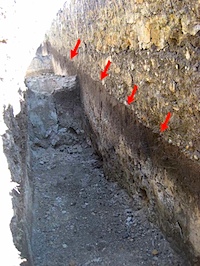
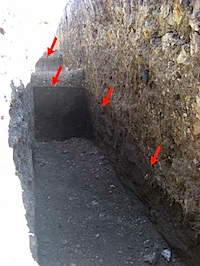 “We wanted to get to new earth,” León replied. Nice! I didn’t know they knew about that; one less thing for me to worry about. In the last post I mentioned differential settling, and digging through the fill dirt will prevent that. And most of the site is cut, so they don’t have to overexcavate much, just on the south wing. I came back a few days later to see that they were done with the trenches, so I climbed in to have a look. Oops, not quite right. Compare these two pictures: the left is correct, with the foundations all stairstepped to sit on virgin earth. The one on the right, though, wasn’t dug deep enough in a few places and some of the loose fill is still on top of the original dirt. You can tell by the line of grass where they piled the new dirt on the old, shown by the arrows (it’s still new enough that the grass poking out is still green!) I mentioned it to León, and he said they’d fix it.
“We wanted to get to new earth,” León replied. Nice! I didn’t know they knew about that; one less thing for me to worry about. In the last post I mentioned differential settling, and digging through the fill dirt will prevent that. And most of the site is cut, so they don’t have to overexcavate much, just on the south wing. I came back a few days later to see that they were done with the trenches, so I climbed in to have a look. Oops, not quite right. Compare these two pictures: the left is correct, with the foundations all stairstepped to sit on virgin earth. The one on the right, though, wasn’t dug deep enough in a few places and some of the loose fill is still on top of the original dirt. You can tell by the line of grass where they piled the new dirt on the old, shown by the arrows (it’s still new enough that the grass poking out is still green!) I mentioned it to León, and he said they’d fix it.
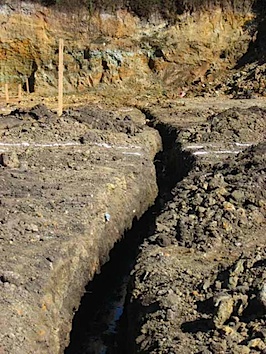 Pascual also was anxious to show me the wet area, and the trench they’d dug to take the water away. We talked about putting in a French drain: a subsurface perforated pipe with gravel on top, so the water can flow away naturally and not collect in my building. Again, León surprised me: I was explaining that the tubes needed to slope 2 in 100 minimum (regardless of units) and 4 in 100 was better. “I was going to do a 3 percent grade”, he replied, not realizing that mathematically those are about the same. Nice!
Pascual also was anxious to show me the wet area, and the trench they’d dug to take the water away. We talked about putting in a French drain: a subsurface perforated pipe with gravel on top, so the water can flow away naturally and not collect in my building. Again, León surprised me: I was explaining that the tubes needed to slope 2 in 100 minimum (regardless of units) and 4 in 100 was better. “I was going to do a 3 percent grade”, he replied, not realizing that mathematically those are about the same. Nice!
I then told him that the sewer pipe and the flood prevention pipe can’t connect, trying to use the simplest words I could find in Spanish. In some places they still permit this, but it’s a terrible idea. “Oh, you mean the greywater and blackwater systems? Of course not!” he said. “I’ve already layed them out to be separate.” I like this guy more and more.
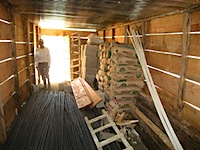 Last weekend, we got our first shipment of material. This is good, since they can only dig for so long before they need concrete and steel. We coordinated with Don and Eulalia (who are handling purchasing) to bring a few truckloads of the things we’ll need first, and continue little by little after that. This is good, because we don’t have the storage space for everything at once, and they will have to use a hundred truckloads to get it all here anyways. Here is ta picture of the bodega (storeroom) with our starter materials.
Last weekend, we got our first shipment of material. This is good, since they can only dig for so long before they need concrete and steel. We coordinated with Don and Eulalia (who are handling purchasing) to bring a few truckloads of the things we’ll need first, and continue little by little after that. This is good, because we don’t have the storage space for everything at once, and they will have to use a hundred truckloads to get it all here anyways. Here is ta picture of the bodega (storeroom) with our starter materials.
So what do we do with them? The masons start fabricating the rebar cages for the various beams and columns. Here we see Mateo making a bending jig. First he built a heavy sawhorse, then he drilled some carefully measured holes. Then he pounded chunks of steel into the holes, to bend the rebar around. A few bends and turns in this jig give him a uniform stirrup every time.
Check out their tools. No DeWalt here. This is the toolbox, open and ready for the day’s work. About half of the tools are simply fabricated from scraps of building material, like this awesome hacksaw. It reminds me of the dark ages, when a new blacksmith was sent into the world with nothing except an anvil. All his dozens of other tools he was expected to make himself from scratch, using one tool to make the next. I respect that kind of self-sufficiency.
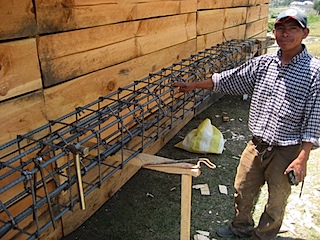 Here is León posing with a rebar cage he just finished. This will be the reinforcement for one of the main columns. I was pleased to see the they followed the “30x bar diameter” rule for lap splicing the steel. When he saw me looking, he got excited and showed me how the verticals were not all spliced at the same point, to maintain the integrity of the column should it experience an earthquake. Nicely done, León!
Here is León posing with a rebar cage he just finished. This will be the reinforcement for one of the main columns. I was pleased to see the they followed the “30x bar diameter” rule for lap splicing the steel. When he saw me looking, he got excited and showed me how the verticals were not all spliced at the same point, to maintain the integrity of the column should it experience an earthquake. Nicely done, León!
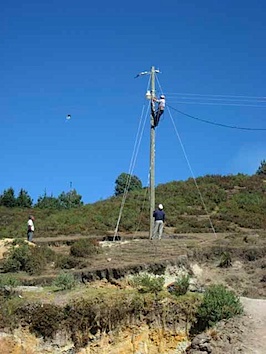 And in a final “good sign”, they hooked up the temporary jobsite electricity today. Here’s the lineman climbing the power pole to make the connection.
And in a final “good sign”, they hooked up the temporary jobsite electricity today. Here’s the lineman climbing the power pole to make the connection.
